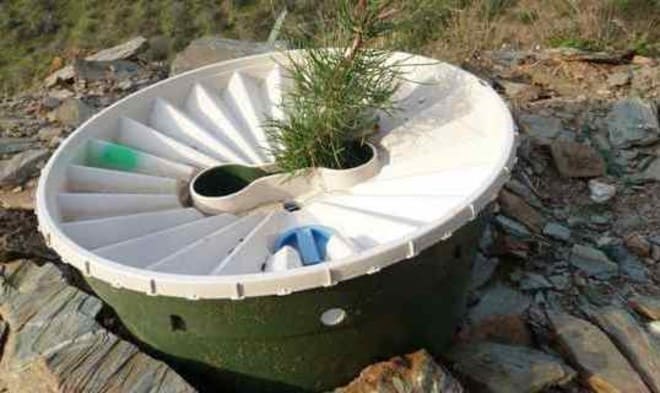The Groasis Waterboxx, an inexpensive, easy-to-use device for planting trees, is helping renovate degraded land and fight desertification from Spain to Ecuador. And the Waterboxx does it without constant irrigation. The Waterboxx device is an incubator for one to three tree saplings, trapping and reusing scarce water resources for long enough to allow the saplings to set down long roots and grow strong.
The idea is simple: The Waterboxx is a double-lidded bucket with a shaft that leads from the bottom through to the top where the saplings can grow. Water is added once at planting. After that, the top lid traps rain and nighttime condensation, trickles it down into the second lid, which prevents evaporation and keeps the sapling’s roots irrigated by means of a wick.
According to Groasis, tests were carried out in Spain and Morocco on saplings which were planted using the Waterboxx and a control group which was planted directly into soil. After three years, 88 percent of the Waterboxx saplings survived, compared to only 10 percent of the control group. The Waterboxx, which received Popular Science’s 2010 Best of What’s New Innovation of the Year award, was developed by Dutch inventor and retired tulip bulb exporter Pieter Hoff.
Deforestation and desertification around the world are critical challenges that lead to a loss in land productivity, poverty and migration, according to the United Nations Convention to Combat Desertification (UNCCD). Reforestation efforts are often hindered by the depth of the groundwater – saplings fail to grow a root structure long enough to reach water before they dry up and wither.
With the Waterboxx, the young saplings are protected from wind and sun by the walls and floor of the bucket. Once the saplings are strong enough, the tree incubator can be removed and reused.
The effects of re-establishing viable growth by planting trees are far reaching, according to the U.N. Food and Agriculture Organization, and include improving soil quality and watersheds, fighting erosion, and reclaiming dryland. The devices are being implemented in a variety of at-risk environments beyond desertified regions, from California wineries threatened by drought to Pennsylvania reforestation projects at abandoned mines.













